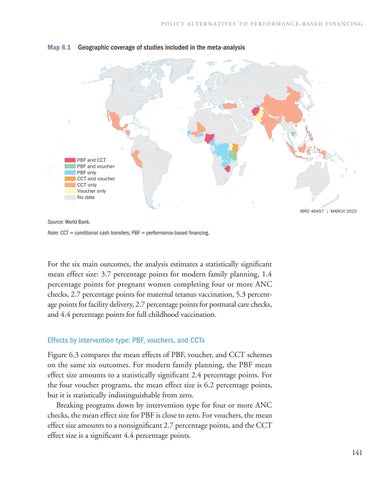POLICY ALTERNATIVES TO PERFORMANCE-BASED FINANCING
Map 6.1
Geographic coverage of studies included in the meta-analysis
PBF and CCT PBF and voucher PBF only CCT and voucher CCT only Voucher only No data IBRD 46457 | MARCH 2022
Source: World Bank. Note: CCT = conditional cash transfers; PBF = performance-based financing.
For the six main outcomes, the analysis estimates a statistically significant mean effect size: 3.7 percentage points for modern family planning, 1.4 percentage points for pregnant women completing four or more ANC checks, 2.7 percentage points for maternal tetanus vaccination, 5.3 percentage points for facility delivery, 2.7 percentage points for postnatal care checks, and 4.4 percentage points for full childhood vaccination. Effects by intervention type: PBF, vouchers, and CCTs Figure 6.3 compares the mean effects of PBF, voucher, and CCT schemes on the same six outcomes. For modern family planning, the PBF mean effect size amounts to a statistically significant 2.4 percentage points. For the four voucher programs, the mean effect size is 6.2 percentage points, but it is statistically indistinguishable from zero. Breaking programs down by intervention type for four or more ANC checks, the mean effect size for PBF is close to zero. For vouchers, the mean effect size amounts to a nonsignificant 2.7 percentage points, and the CCT effect size is a significant 4.4 percentage points. 141

